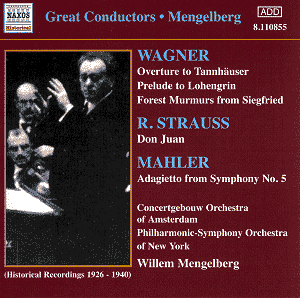The latest in Naxos’s Great Conductors series devoted
to Willem Mengelberg is a particularly resplendent one, drawing together
three composers whose works he played with especial authority. Not only
that but the recordings were made between 1926 and 1940 with the Concertgebouw
and the Philharmonic-Symphony of New York, the two orchestras most closely
associated with him. The first three Wagner Preludes and the Tannhäuser
Overture span the years – 1927, 1932 and 1940.
The larger than life impression generated by Mengelberg
finds its amplitude and weight in Wagner. The Tannhäuser Overture
(Dresden version) has a massive string coagulation, with brass coursing
through the thick textures, string figures almost telepathically anticipating
the beat. The flutes and the solo violin (Helman, Zimmerman?) make their
presence felt as do the cavernous basses, picked up with such astonishing
fidelity in the hall in May 1932. Mengelberg slightly retards the rhythm,
creating an expectant wave of emphatic drama and the way in which he
cues in the horns at the peroration is simply staggering. But this is
no hell-for-leather orchestral showpiece. Sectional discipline is maintained
and a proper tempo is maintained. There are plenty of portamenti in
the Lohengrin Overture – pervasive and uniform – but also a deeply considered
and inevitably produced powerful force; there is tremendous intensity.
His Meistersinger Prelude is cosmopolitan and powerfully busy. The flute
and horn lines are both exposed and nicely tapered and Mengelberg doesn’t
rush on to the climaxes, instead holding back. As a result whilst the
ending is measured and sensitive it’s not as sheerly exciting as it
could have been.
With Siegfried we are back in New York in 1928. The
clarinets pipe deliciously, there is a verdant evocation during and
after the lengthy string introduction – a sense too of crepuscular depth
and an additional pleasure in the broad singing tone of the orchestra’s
leader (Scipione?) The Humperdinck was recorded in the Liederkranz Hall
and receives a delightful performance but with Don Juan we are back
in Amsterdam. There is sometimes rather too much sectionality in Mengelberg’s
traversal, a feeling of indulgence perhaps; at heightened expressivity
Mengelberg encourages gorgeous if by then anachronistic portamenti.
Finally we have the famous, oft cited Adagietto (all 7.09 of it) from
Mahler’ Fifth Symphony – Mengelberg’s only commercially recorded Mahler
– and full of expressive raptness and motion, portamento-laced and burnished.
Ian Julier brings his acumen to bear on some stylistic
and other matters in his notes and Mark Obert-Thorn has worked hard
to correct pitch and recessive problems in the originals. With the bulk
of his Wagner overtures here and Strauss and Mahler too this makes for
a lucid and lastingly valuable selection for the library shelves.
Jonathan Woolf
